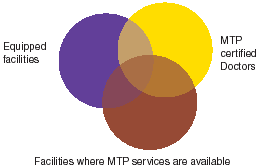
Abortions are a major
cause of maternal morbidity and mortality in India. Estimated number
of abortions a woman will have throughout her reproductive years
is 1 to 2.6. Estimated annual number of induced abortions varies
nationwide from 0.6 (GOI, 1991-92) to 6.7 million (Chhabra and Nuna,
1994).
Table
1.1.1
Estimated annual number of induced abortions nationwide |
|
| Source |
Induced
abortions (million) |
|
Shah, 1966
IPPF, 1970
Goyal et al, 1976
ICMR, 1990 (based on 1988 estimates)
UNICEF, 1991
GOI, 1991-92
Chhabra and Nuna, 1994 |
3.9
6.5
4.6
1.9
5.0
0.6
6.7 |
|
The statistics of induced abortions in India is grossly inadequate
as hospital records cover only legal and reported abortions. NFHS
surveys also underestimate the true levels. Indirect estimates mainly
depend on ratio of induced abortions to live-births, ill-timed and
unwanted pregnancies, age specific fertility rates and Bongaart’s
proximate determinants of fertility. The ratio of illegal to legal
abortions varies from 2:1 (ICMR, 1983-84) to 10:1 (Khan et al, 1998).
Maternal mortality attributable to abortions in India is 12-18%
and is mostly contributed by illegal abortions
nationwide.
Unsafe abortions are also an important cause of morbidity in the
form of pelvic infections including grade-III sepsis (with peritonitis,
septicaemia, septic shock, acute renal failure and DIC), incomplete
abortion, haemorrhage and terine or cervical injury. Reliable data
on mortality are not available.
Table
1.1.2
Estimated annual number of induced abortions nationwide |
|
| Location |
Maternal deaths
attributable to
abortion (%) |
Source |
|
| India, 1982-83 |
18.1
|
ICMR |
| India, Rural, 1989 |
10.8 |
Table 1.1.1 Office of the
Registrar General,1991 |
| India, Rural,1993 |
11.7 |
Office of the registrar
General,1993 |
| India,1993-1994 |
12.6 |
ICMR Task Force, 1998 |
| India,1994 |
12.6 |
GOI, 1998 |
| India,1991-1995 |
18.0 |
Office of the Registrar General, N.D. |
|
| The facilities for safe abortions fall short
of the need of abortion as reported MTPs are about 600,000 per
year but total induced abortions are estimated at between 1.9
and 6.7 million. Under-reporting by government and private institutions
is a major reason. In India, certified facilities for MTP have
increased from 1877 to 9271 between 1972 and 1993-94. States
with the highest number of MTP facilities per 100,000 population
are Maharashtra, Kerela, Gujarat, Haryana and Punjab. There
is a mismatch between availability of government-equipped facilities,
MTP-certified doctors and facilities where services are available. |
 |
Regarding indirect estimates of abortions, a very high rate of
induced abortions is seen in Nagaland, Bihar, Meghalaya, Arunachal
Pradesh, Uttar Pradesh, Orissa, Madhya Pradesh, West Bengal, Assam
and Tripura.
A variety of methods in use for MTP include D&C, Electronic
Vacuum Aspiration (EVA) and Manual Vacuum Aspiration (MVA) in first
trimester, extraamniotic and intraamniotic instillations and D&E
in the second trimester. MTP training centers (teaching hospitals),
however, prefer EVA, D&C and induction methods and only 25%
doctors are trained in MVA (CORT, 1995-97). There is a large range
of clandestine abortion-providers that vary in the country from
doctors (including those who are uncertified ‘safe illegal
providers’) to Ayurvedic practitioners, homeopaths, Auxillary
Nurse Midwives (ANMs), nurses, compounders, spouses or attendants,
untrained practitioners, Traditional Birth Attendants (TBAs), shopkeepers,
etc.
Methods used by informal providers vary from tablets (ayurvedic
preparations, papaya seeds, chloroquin tablets, high-dose progesterone
and highdose estrogen and progesterone) injections (carboprost and
ayurvedic preparations), surgical methods (D&C, catheters, intra-amniotic
saline or glycerine) to intravaginal sticks, roots, iodine-benzoin
paste, decoctions and massage, papaya and custard apple seeds etc.
Action Research and Training in Health (ARTH) is conducting a study
of abortion services in Rajasthan (2002) and has mapped all health-
providers in 5 rural and 1 urban block of two districts (Population
1,388,687). Out of a total 1746 providers, 78% were practising paramedics
and private unqualified persons, 5% Indian System of Medicine (ISM)
practitioners and 17% medical doctors. Population per provider was
4700 for doctors, 958 for other categories, which are also better
dispersed within rural interiors and urban slums. Almost half (48%)
of informal providers (all except medical doctors) provided abortion
services as treating delayed periods. Methods employed by informal
providers ere tablets in 55%, injections in 36%, and massage/herbs
in 5% as compared toinvasive methods in 4%. Informal roviders seemed
to prefer ‘medical methods’.
Most women who seek abortions are 20-35 years old, married with
3 or more children and wish to limit their families and seek abortion
services especially in the first trimester (ICMR 1989). Second trimester
abortions represent 10-40% of all abortions (ICMR 1981) and are
more likely to be seen among adolescents and women seeking sex selective
abortions. More than 11% second trimester abortions have been reported
in Rajasthan and Uttar Pradesh, 60% in Orissa and 35% in Tamil Nadu.
Abortions among adolescents vary from 5.7% of all abortions in
urban government hospital settings to 27- 30% of all abortions in
some clinics (Chhabra 1988, Solapurkar and Sangam, 1985) and 59-76%
of abortions among unmarried adolescents are in second trimester
(Chhabra 1988; Aras, 1987). Abortions in adolescents are more likely
to be performed by untrained persons in unhygienic conditions and
can contribute to 20% of all abortion-related deaths among adolescents
(GOI).
Safe abortion services in India remain inaccessible in rural areas
despite MTP Act and Rules because facility and provider requirements
are restricted and geographical distribution of facilities is skewed.
Most private facilities exist in cities and most rural government
facilities do not provide abortion services.
Certified facilities have low caseloads due to lack of confidentiality,
high costs, difficult consent, and pressure to accept sterilization
or IUD. Even at many government facilities, services are not available
due to lack of trained doctors, functional equipments, anaesthetists
and electricity (Barge et al, CORT 1998) and limited training capacity.
There are limited MTP training facilities with merely 166 MTP training
institutions in 1994. Given such a situation, where safe abortion
services are not easily accessible, the problem of abortion is of
great magnitude and makes a major contribution to maternal deaths.
The question arises as to how best can medical methods
be used to enhance access to safe abortion in India. |









